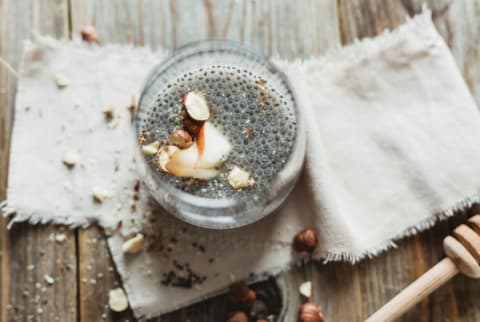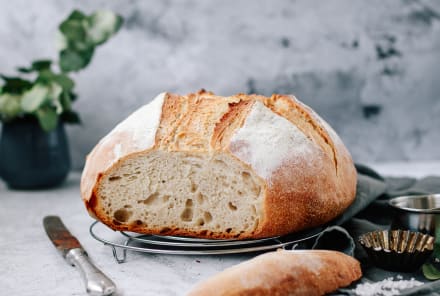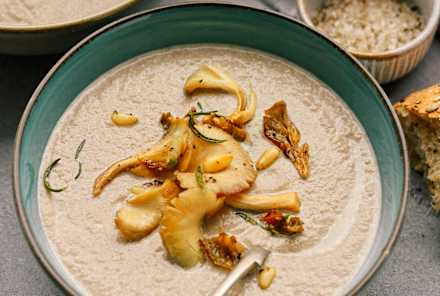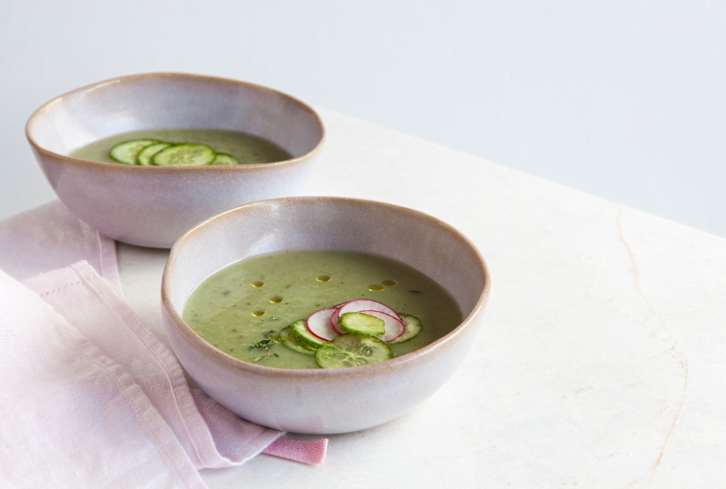Advertisement
The Definitive Guide To Chia Seeds: Why They're Good For You + What To Do With Them


The secret to being a great cook is all in understanding your ingredients. The Definitive Guide To … will take you beyond the recipes, giving you expert insight into everything from trendy new superfoods to seasonal produce favorites. You'll learn what they are, why they're amazing for you, techniques to use them in fun, creative ways, and — of course — tons of recipes, so you can put your new skills to the test!
Let's kick it off with chia seeds, an ingredient that's becoming more and more popular lately. You may have seen them pop up on the menu at your local juice shop or noticed them in the ingredients list of your favorite energy bar, but do you know what they actually are?
Maybe you vaguely know they're good for you — they're a superfood, right?! — but you have no idea what they're actually doing in your body (something ... super?). Maybe you've thrown them in smoothies or even made chia pudding, but have you used them in place of eggs in baked goods?
Yeah, but what are chia seeds?

Chia seeds are the, well, seed of the chia plant, which is part of the mint family. While the leaves are occasionally consumed as an herbal tea, it's the seeds that most people are after.
Native to South America, there's evidence of chia seeds being used as early as the 1500s by Aztec tribes. While you might see claims on packages proclaiming chia the Aztec go-to for increased stamina on the battlefield and in bed, there isn't actually any proof of this, although chia is the ancient Mayan word for "strength" (take note, celebrities looking for crazy baby names).
What we do know definitively: Chia seeds pack an amazing nutritional punch. One ounce of chia seeds contains a whopping 11 grams of fiber, 4 grams of protein, 18 percent of your recommended daily value (RDA) of calcium, 30 percent of your RDA of both manganese and magnesium, and 27 percent of your RDA of phosphorus.
They also contain 5 grams of omega-3s, although it's best to be cautious about health claims involving this, as the type of omega-3s chia contains is mostly ALA (alpha-linolenic acid), which the human body is inefficient at converting into DHA and EPA, which are the omega-3s that can actually be used by the body.
While you might be better off munching some wild-caught salmon if you're looking for solely omega-3s, if you're looking for something that will keep you full for hours (that protein! that fiber!), may help prevent cancer (chia seeds are high in antioxidants, which fight the production of cancer-contributing free radicals), and make you relaxed (hey there, magnesium!), chia seeds should be your new go-to.
OK, but what can you actually use chia seeds for?
Where chia seeds really stand out from the pack, though, is in their versatility. They can be incorporated so easily, and in so many forms, into your diet that there's no real excuse not to include them.
Because the hard, small seed develops a gelatinous coating when submerged in liquid, chia can be used as a thickener, as a binder, as jam, or simply eaten on its own as a rich, creamy pudding.
Let's go simple: I want the chia pudding!
If you're going for a puddinglike consistency, your magic ratio is 1 cup of liquid to 3 tablespoons of chia seeds.
Simply stir the chia seeds into the liquid and let it sit for about 30 minutes, or until it's become thick, gooey and, well, pudding-like in texture.
From there, you can blend the mixture if you'd like super-creamy pudding, or eat it as is if you like a bit of texture. Great liquid bases include any kind of nut milk with a bit of sweetener (honey, coconut syrup, rice malt syrup, or even blended dates) and a pinch of sea salt.
Add some vanilla extract and you've got vanilla chia pudding; throw a few teaspoons of cocoa or raw cacao powder in there and you’ve got chocolate chia pudding. The sky's really the limit for flavor, but here are a few of my favorite recipes:
Jam’s my jam

Chia jam might be my favorite way to use the super seeds. Normal jam making is time-consuming and sweaty, but chia jam takes minutes — plus, you don't need any sugar outside of that which comes from the fruit itself!
To make jam out of berries, put said berries in a small pot and cook, stirring frequently, over medium heat until fruit begins to break apart and become jammy. You can use fresh or frozen fruit for this, but stick to berries, as other fruit is too watery or fibrous and won’t produce the right texture.
When the berries have broken apart, sprinkle with chia seeds. No need to be exact, but I like to use about 1 cup of fresh or frozen berries to every 1 to 2 teaspoons of chia seeds.
Feel free to add lemon juice to brighten the flavor, rose water, cinnamon, or other spices, and a teaspoon or two of natural sweetener if you desire. Play around!
You can use chia jam like you'd use normal jam — on toast, as a topper for oatmeal or cookies, or layered with yogurt in a parfait:
Chia can replace eggs?! How does that work?
Because of the sticky, gooey texture chia seeds take on when they're hydrated and their high protein content, they make wonderful egg replacements in most baked good recipes (please stick to baked goods, though — you'll have less success if you try to fry one of these sunny-side up).
To make one chia egg, simply grind up 1 tablespoon of chia seeds until powdery using a coffee or spice grinder, a food processor, or a mortar and pestle. Add 3 tablespoons of water, and let sit until thickened, about 5 minutes, then sub 1:1 with any eggs in baked good recipes.
Note that you'll want to grind chia fresh for each use, as their high-fat content makes them prone to spoilage. This works in most baking recipes, but here are a few of my favorites:
What if I want to make something Jay & Bey-level rich?

You’ll often find chia seeds on the menu at smoothie shops because of both their amazing health benefits and because they act as a wonderful thickener, adding a creamy, decadent touch to recipes (especially when blended). You can use this in anything with a liquid base, from smoothies to ice pops.
You don't need to be as precise with measurements with this one since you're just using it to add weight and heft, but in general, I like to go with about 1 tablespoon of chia seeds to every cup of liquid. If you use more, your mixture will be thicker; if you use less, it'll be thinner.
Again, blend if you want it to be totally smooth. Creamy liquid will make more of a milkshake consistency while juices and other more watery liquid will make what's called a chia fresca, which is hailed all over internet-landia as an all-natural, sup-r hydrating energy drink. It's particularly great in ice pops, where it lends a dairy-free, Fudgesicle-like richness.
The biggest take-away: Play around!
People discovered all of the fun uses for chia seeds over time by actually using them, so experiment in your kitchen and have fun. Share pictures of your creations or tell us what other ingredients you'd like a definitive guide to, using the hashtag #mbgdefinitiveguide, and happy eating!
Watch Next
Enjoy some of our favorite clips from classes
Enjoy some of our favorite clips from classes
What Is Meditation?
Mindfulness/Spirituality | Light Watkins
Box Breathing
Mindfulness/Spirituality | Gwen Dittmar
What Breathwork Can Address
Mindfulness/Spirituality | Gwen Dittmar
The 8 Limbs of Yoga - What is Asana?
Yoga | Caley Alyssa
Two Standing Postures to Open Up Tight Hips
Yoga | Caley Alyssa
How Plants Can Optimize Athletic Performance
Nutrition | Rich Roll
What to Eat Before a Workout
Nutrition | Rich Roll
How Ayurveda Helps Us Navigate Modern Life
Nutrition | Sahara Rose
Messages About Love & Relationships
Love & Relationships | Esther Perel
Love Languages
Love & Relationships | Esther Perel
What Is Meditation?
Box Breathing
What Breathwork Can Address
The 8 Limbs of Yoga - What is Asana?
Two Standing Postures to Open Up Tight Hips
How Plants Can Optimize Athletic Performance
What to Eat Before a Workout
How Ayurveda Helps Us Navigate Modern Life
Messages About Love & Relationships
Love Languages
Advertisement

4 Habits To Add To Your Morning Routine, From A Functional Nutrition Training Alum
Ximena Araya-Fischel, M.A

4 Habits To Add To Your Morning Routine, From A Functional Nutrition Training Alum
Ximena Araya-Fischel, M.A

















